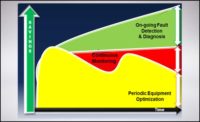How can we adapt to a world that was, is, and will be? How can we adapt to a future that is unknown? Can we make it known by utilizing the concept of digital twins and go beyond buildings? Can we simulate the future, having done thousands of AI-driven simulations, and bring the solutions back to the now, knowing what the future will look like?
Knowing that the future is already here, only unevenly distributed, I have made it my mission to find the tools that can distribute the future to the ones who want it the most. Digital twins are being quite hyped right now, so I thought I could stir up some noise even more with digital triplets.
What started off as a joke soon became reality in a couple of conversations with partners and vendors. Recently, I talked to legends in the power industry who have written articles about triplets. It came up in discussions with industrial automation professionals regarding simulation capabilities. I mentioned 6G, 7G, or 8G and digital triplets in a recent webinar, as well, to make a point that we need to talk more about the jobs to be done instead of the buzzword bingo being tossed about right now.
The need to adapt to existing ways of working was also discussed in a webinar [i] for Chalmers University and The Digital Twin City Centre about revenue and business models. The importance of understanding the concept, situation, and unique problems that should be solved cannot be emphasized enough, where existing companies are indeed built to die[ii].
Finding inspiration is not the challenge — that is just a Google away. Finding what problems to solve, and how to solve them in their unique setting with culture, processes, people, existing systems, and political agendas, can only be discovered by digging into the reality that exists. It is known that digital twins can accelerate digital transformation efforts. But a lot of the real use cases are yet to be discovered at scale.
But what even are digital twins and what are the main parts they’re made of?
"The digital twin is made up of three parts: physical entities in the real world, virtual models of those entities, and the data that connects the two worlds,” according to an article that recently appeared in CIO Applications.
According to that article, a Digital Twin is made up of a virtual model of what's being "twinned" and the data that connects them. What if there are hundreds of assets, spanning factories, weather, processes, people, and systems in a supply chain? And what about the context? What about the need for visualizations? And what about the need for simulations to be made? Maybe all these things are included and more because digital twins can bring real-time data together with the static and are gaining ground where PLM tools falter. That description of a digital twin feels a bit thin.
So, maybe there was some truth to digital triplets after all?
Out from a proprietary past and into an open, interoperable future
In one of the discussions with one of the largest multinational power companies in Europe, we talked about the need for an "operational twin," and a “simulation/sandbox twin.” They had tried to create a digital twin of one of their gas-turbine driven power plants but saw these challenges below (and more):
• Problems with general data protection regulation (GDPR), sending data to "a" cloud halfway around the world;
• Offered AI-solutions being black-box entities;
• Impossible to continue to optimize the algorithms and AI-solution themselves;
• The proposed solutions were not built on open source nor interoperable enough;
• The solutions were not able to run on the edge/on-prem behind firewalls;
• All the solutions were based on manual ways of working in need of experts. Where they were after more automated ways of working;
• A need for AR/VR having seen Microsoft Mesh "Here can be everywhere" for Remote maintenance and training; and
• All the solutions were unable to provide a copy-paste function to other power-plants, re-using intelligence without having to re-invent the wheel at every turn.
The jobs to be done here seem to go from where they are today, out from a proprietary past, and into an interoperable and scalable future. And now we have the ability to augment, and possibly re-invent, existing ways of working in a transparent way.
All of these challenges can be solved through various ways that exist right now; the technologies are finally here to make the future happen. But, what was even more interesting was their rhetoric around digital twins. One of the things they were after were digital representations of the physical world that they called the operational digital twin, which should always mirror the real world.
I found this to be very similar to what the article from CIO Applications defined as digital twins. But, what they were after even more was a sandbox environment and the ability to run simulations on top of the digital twin to feed data back to the digital twin.
Digital Triplets?
"The digital twin is made up of three parts: physical entities in the real world, virtual models of those entities, and the data that connects the two worlds," states the CIO Applications article.
Reading that quote again, I cannot help but think if there is need for digital triplets? Or is it just a lack of understanding thus far as to what capabilities digital twins have? And will the road toward triplets will lead to siblings, cousins, and go beyond that of triplets and quadruplets and turn into a digital slippery slope? Most likely. So, for now, let’s continue with digital twins and further ask some questions regarding what they are and could be.
Is it possible to say that people should build the digital twin first and then the physical counterpart will follow? Maybe it is just back from the future with digital twins, where the simulation side of things is added as one possible dimension of many capabilities of a digital twin initiative. But is it possible to get started on the digital twin journey without having a physical asset? Is it more than possible and should even be recommended?
“Does a digital twin always need a physical counterpart?”
This is one of many topics that will be covered at Beyond Buildings.
Other questions for discussion:
- Is there a need to exemplify the different capabilities digital twins can have in a simple way? Does it exist already?
- Should the digital twin have the ability to run simulations on its own, or should third-party applications be able to work with the digital twin in an interoperable way?
- Should the digital twin be able to work with existing systems and bring its native capabilities together to adapt to the world that already exists?
- Or should the digital twin platform on its own have all the capabilities necessary to bring everything together forever?
- Should digital twins be able to work with any standard and how to work with AI-enablement at scale?
- Do digital twins start to exist when they have the capabilities to work with model ingestion, virtual sensors, or something else entirely up until that point?
- Do digital twins need to be accompanied with virtual and possibly visual digital twins to capture the importance of the visual and the virtual part of the digital twin?
- If a building has not one but hundreds of interoperable digital twins of the assets as well as their context, what happens to the digital twins if they lose their physical counterparts?
- Is this not where the true value lies in reusing intelligence and true separation of the boundaries of the real world?
- Is it not the true value of the digital twin to exist in the digital and virtual realm and to be able to re-use the intelligence gained for new projects, knowing what will happen beforehand?
- How can virtual models, tools, and AI-driven simulations be used to emulate reality to understand what the future will look like?
If the new construction of a hospital can re-use the intelligence from a demolished hospital (and or a virtual hospital) and modify it so that a new one can be built and modified 95% faster than before to match the reality where it will be built, is that not the true purpose of having digital twins? Shouldn’t they be used to transcend product management life cycles into true meta-verse enablement? Into such an instance where we can record reality and truly transcend the shackles of having to do something in reality first, and only afterwards utilize digital tools and technologies?
How important is the visual component to bring people and systems together? (More on that on the next episode at the Beyond Buildings Podcast)
And do we need to wait for digital twin standards or should we get going with digital twin approaches that are interoperable, built on open source, and can work with any standard?
All I know is that we need to help companies where they are today and get them to where they need to be tomorrow. Most companies today are experiencing severe challenges in turning data into information with data made by humans. What will happen when data is being created thousands of times faster from machines?
That is the thing. Virtual digital twins are some of the best tools out there right now in bringing people and systems together like nothing before. And some of the platforms can start anywhere to scale anywhere. The visualization aspects are much more important than what people seem to think, and the ones that get to a digital operating model and business model will soon find themselves leading the pack, knowing it is the fast that eat the slow.
Distributing future ways of working
The future is coming at us fast. Adapting to the future based on the unique needs of companies where they are today and where they need to be tomorrow is what is needed. It is not about stepping out of the comfort zone for people. It never was. It is about stepping into the comfort zone and describing what that is in ways that people as well as systems can understand at scale. It is all about bringing people and systems together and utilizing the power of experts in various areas to innovate with the world that exists today. We cannot keep continuing to expect that people need to change when they do not want to.
Define the jobs to be done and stay in your comfort zone. Then, invite people to innovate with the world they know best. Easy, right?
This article originally appeared in the April issue of www.automatedbuildings.com. See it in its entirety at http://www.automatedbuildings.com/news/apr21/articles/nicolas/210331124001nicolas.html







